Food Policy Report: Promoting Healthy and Sustainable Food Systems
VerifiedAdded on 2022/12/29
|13
|4414
|1
Report
AI Summary
This report analyzes the current food policy in Australia, highlighting the gap between the existing national diet and the principles of healthy and sustainable eating. It begins by defining healthy and sustainable diets, outlining their characteristics and benefits, and then compares them with the current national diet, which is based on the five food groups, and explores the consumption of animal-based versus plant-based foods, and discretionary foods. The report then delves into the challenges posed by the current food system, including the prevalence of unhealthy eating habits and the impact of food supply chains. It also examines public activities and the role of agriculture in shaping dietary patterns. Finally, the report formulates a national food policy, proposing a set of actions to promote healthy and sustainable food systems, including strengthening sector policies, supporting farmers, and focusing on local food processing organizations. The report emphasizes the need for collaboration between government and private sectors, and the importance of addressing the environmental and health impacts of food choices.
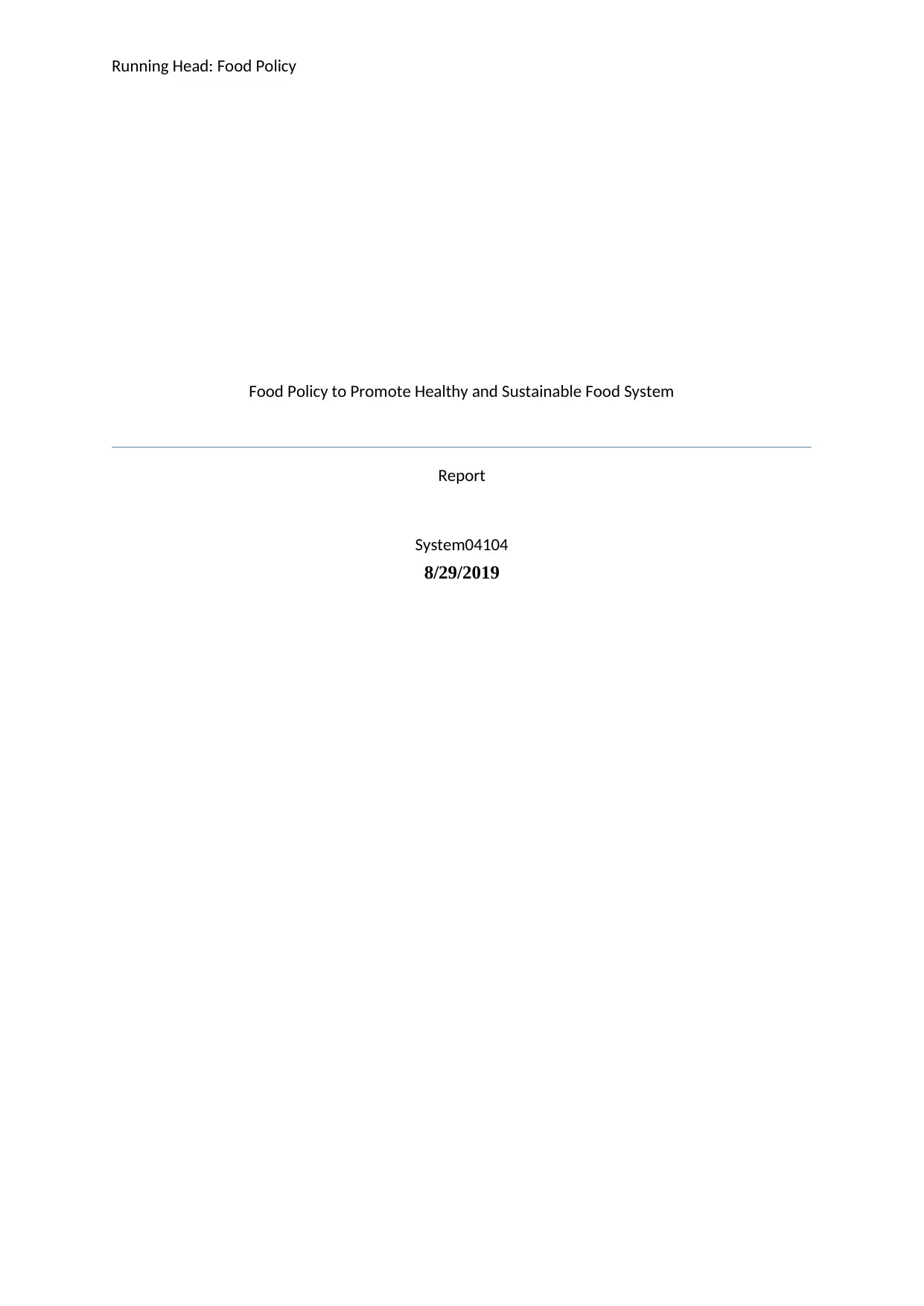
Running Head: Food Policy
Food Policy to Promote Healthy and Sustainable Food System
Report
System04104
8/29/2019
Food Policy to Promote Healthy and Sustainable Food System
Report
System04104
8/29/2019
Paraphrase This Document
Need a fresh take? Get an instant paraphrase of this document with our AI Paraphraser
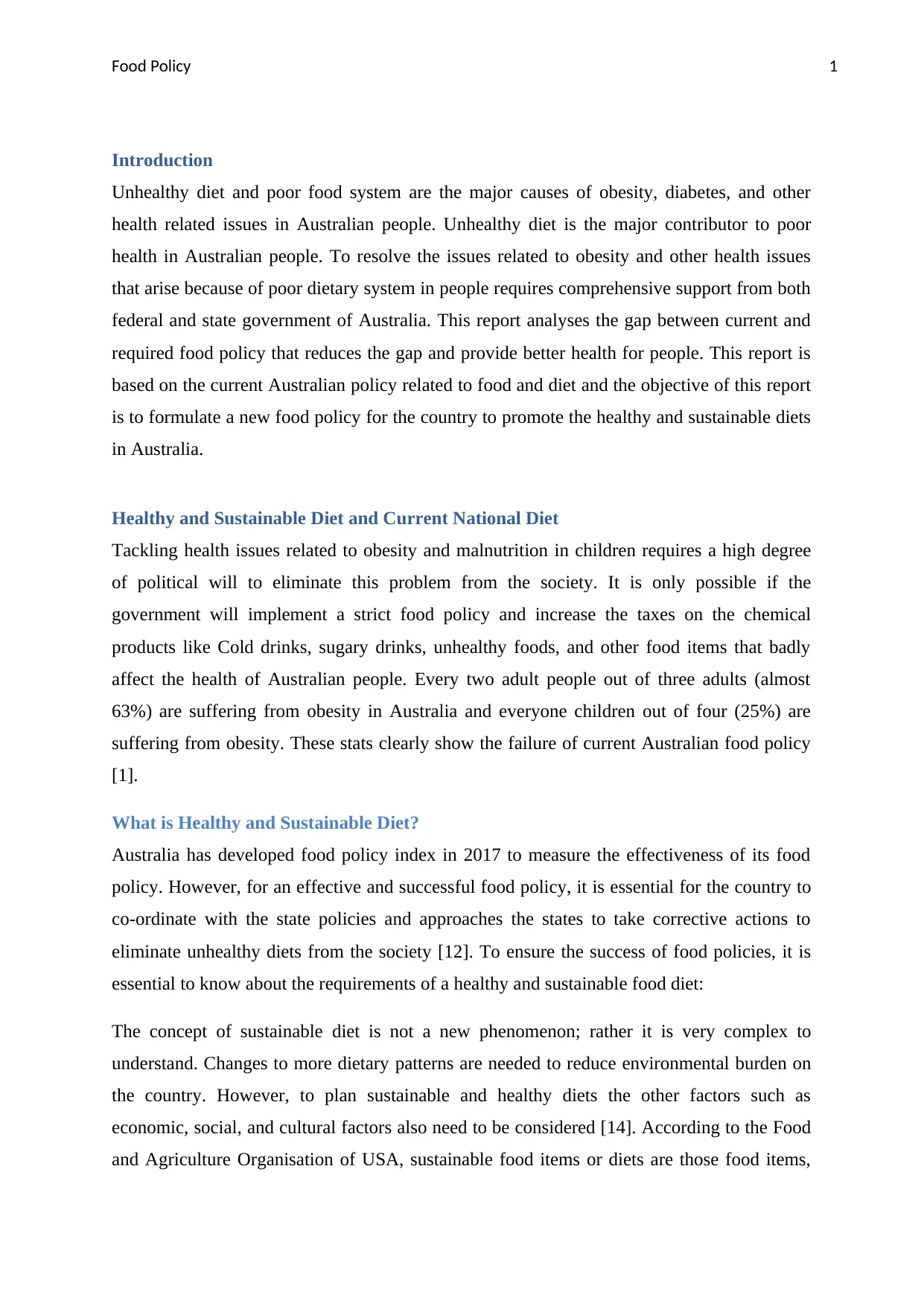
Food Policy 1
Introduction
Unhealthy diet and poor food system are the major causes of obesity, diabetes, and other
health related issues in Australian people. Unhealthy diet is the major contributor to poor
health in Australian people. To resolve the issues related to obesity and other health issues
that arise because of poor dietary system in people requires comprehensive support from both
federal and state government of Australia. This report analyses the gap between current and
required food policy that reduces the gap and provide better health for people. This report is
based on the current Australian policy related to food and diet and the objective of this report
is to formulate a new food policy for the country to promote the healthy and sustainable diets
in Australia.
Healthy and Sustainable Diet and Current National Diet
Tackling health issues related to obesity and malnutrition in children requires a high degree
of political will to eliminate this problem from the society. It is only possible if the
government will implement a strict food policy and increase the taxes on the chemical
products like Cold drinks, sugary drinks, unhealthy foods, and other food items that badly
affect the health of Australian people. Every two adult people out of three adults (almost
63%) are suffering from obesity in Australia and everyone children out of four (25%) are
suffering from obesity. These stats clearly show the failure of current Australian food policy
[1].
What is Healthy and Sustainable Diet?
Australia has developed food policy index in 2017 to measure the effectiveness of its food
policy. However, for an effective and successful food policy, it is essential for the country to
co-ordinate with the state policies and approaches the states to take corrective actions to
eliminate unhealthy diets from the society [12]. To ensure the success of food policies, it is
essential to know about the requirements of a healthy and sustainable food diet:
The concept of sustainable diet is not a new phenomenon; rather it is very complex to
understand. Changes to more dietary patterns are needed to reduce environmental burden on
the country. However, to plan sustainable and healthy diets the other factors such as
economic, social, and cultural factors also need to be considered [14]. According to the Food
and Agriculture Organisation of USA, sustainable food items or diets are those food items,
Introduction
Unhealthy diet and poor food system are the major causes of obesity, diabetes, and other
health related issues in Australian people. Unhealthy diet is the major contributor to poor
health in Australian people. To resolve the issues related to obesity and other health issues
that arise because of poor dietary system in people requires comprehensive support from both
federal and state government of Australia. This report analyses the gap between current and
required food policy that reduces the gap and provide better health for people. This report is
based on the current Australian policy related to food and diet and the objective of this report
is to formulate a new food policy for the country to promote the healthy and sustainable diets
in Australia.
Healthy and Sustainable Diet and Current National Diet
Tackling health issues related to obesity and malnutrition in children requires a high degree
of political will to eliminate this problem from the society. It is only possible if the
government will implement a strict food policy and increase the taxes on the chemical
products like Cold drinks, sugary drinks, unhealthy foods, and other food items that badly
affect the health of Australian people. Every two adult people out of three adults (almost
63%) are suffering from obesity in Australia and everyone children out of four (25%) are
suffering from obesity. These stats clearly show the failure of current Australian food policy
[1].
What is Healthy and Sustainable Diet?
Australia has developed food policy index in 2017 to measure the effectiveness of its food
policy. However, for an effective and successful food policy, it is essential for the country to
co-ordinate with the state policies and approaches the states to take corrective actions to
eliminate unhealthy diets from the society [12]. To ensure the success of food policies, it is
essential to know about the requirements of a healthy and sustainable food diet:
The concept of sustainable diet is not a new phenomenon; rather it is very complex to
understand. Changes to more dietary patterns are needed to reduce environmental burden on
the country. However, to plan sustainable and healthy diets the other factors such as
economic, social, and cultural factors also need to be considered [14]. According to the Food
and Agriculture Organisation of USA, sustainable food items or diets are those food items,
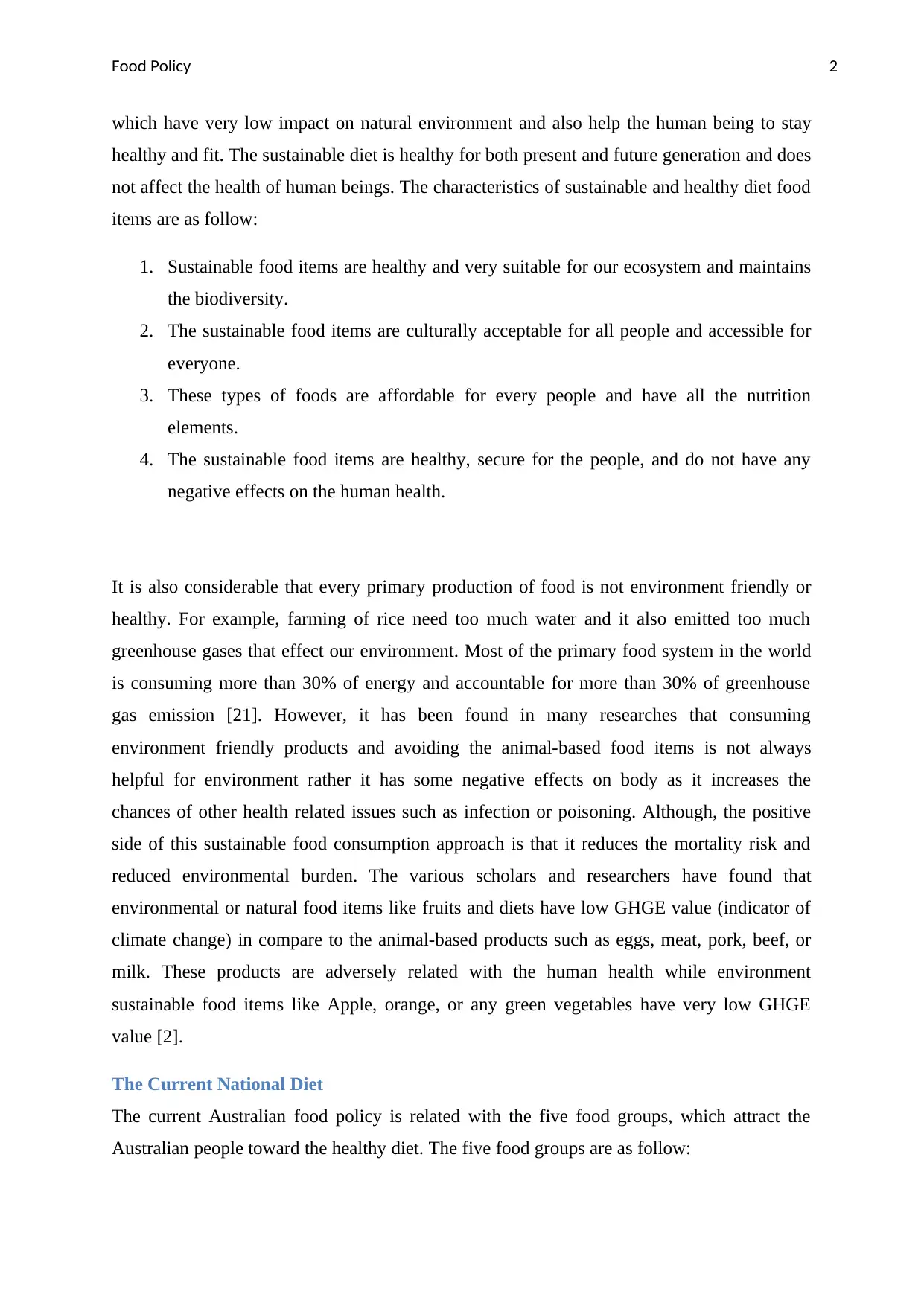
Food Policy 2
which have very low impact on natural environment and also help the human being to stay
healthy and fit. The sustainable diet is healthy for both present and future generation and does
not affect the health of human beings. The characteristics of sustainable and healthy diet food
items are as follow:
1. Sustainable food items are healthy and very suitable for our ecosystem and maintains
the biodiversity.
2. The sustainable food items are culturally acceptable for all people and accessible for
everyone.
3. These types of foods are affordable for every people and have all the nutrition
elements.
4. The sustainable food items are healthy, secure for the people, and do not have any
negative effects on the human health.
It is also considerable that every primary production of food is not environment friendly or
healthy. For example, farming of rice need too much water and it also emitted too much
greenhouse gases that effect our environment. Most of the primary food system in the world
is consuming more than 30% of energy and accountable for more than 30% of greenhouse
gas emission [21]. However, it has been found in many researches that consuming
environment friendly products and avoiding the animal-based food items is not always
helpful for environment rather it has some negative effects on body as it increases the
chances of other health related issues such as infection or poisoning. Although, the positive
side of this sustainable food consumption approach is that it reduces the mortality risk and
reduced environmental burden. The various scholars and researchers have found that
environmental or natural food items like fruits and diets have low GHGE value (indicator of
climate change) in compare to the animal-based products such as eggs, meat, pork, beef, or
milk. These products are adversely related with the human health while environment
sustainable food items like Apple, orange, or any green vegetables have very low GHGE
value [2].
The Current National Diet
The current Australian food policy is related with the five food groups, which attract the
Australian people toward the healthy diet. The five food groups are as follow:
which have very low impact on natural environment and also help the human being to stay
healthy and fit. The sustainable diet is healthy for both present and future generation and does
not affect the health of human beings. The characteristics of sustainable and healthy diet food
items are as follow:
1. Sustainable food items are healthy and very suitable for our ecosystem and maintains
the biodiversity.
2. The sustainable food items are culturally acceptable for all people and accessible for
everyone.
3. These types of foods are affordable for every people and have all the nutrition
elements.
4. The sustainable food items are healthy, secure for the people, and do not have any
negative effects on the human health.
It is also considerable that every primary production of food is not environment friendly or
healthy. For example, farming of rice need too much water and it also emitted too much
greenhouse gases that effect our environment. Most of the primary food system in the world
is consuming more than 30% of energy and accountable for more than 30% of greenhouse
gas emission [21]. However, it has been found in many researches that consuming
environment friendly products and avoiding the animal-based food items is not always
helpful for environment rather it has some negative effects on body as it increases the
chances of other health related issues such as infection or poisoning. Although, the positive
side of this sustainable food consumption approach is that it reduces the mortality risk and
reduced environmental burden. The various scholars and researchers have found that
environmental or natural food items like fruits and diets have low GHGE value (indicator of
climate change) in compare to the animal-based products such as eggs, meat, pork, beef, or
milk. These products are adversely related with the human health while environment
sustainable food items like Apple, orange, or any green vegetables have very low GHGE
value [2].
The Current National Diet
The current Australian food policy is related with the five food groups, which attract the
Australian people toward the healthy diet. The five food groups are as follow:
⊘ This is a preview!⊘
Do you want full access?
Subscribe today to unlock all pages.

Trusted by 1+ million students worldwide
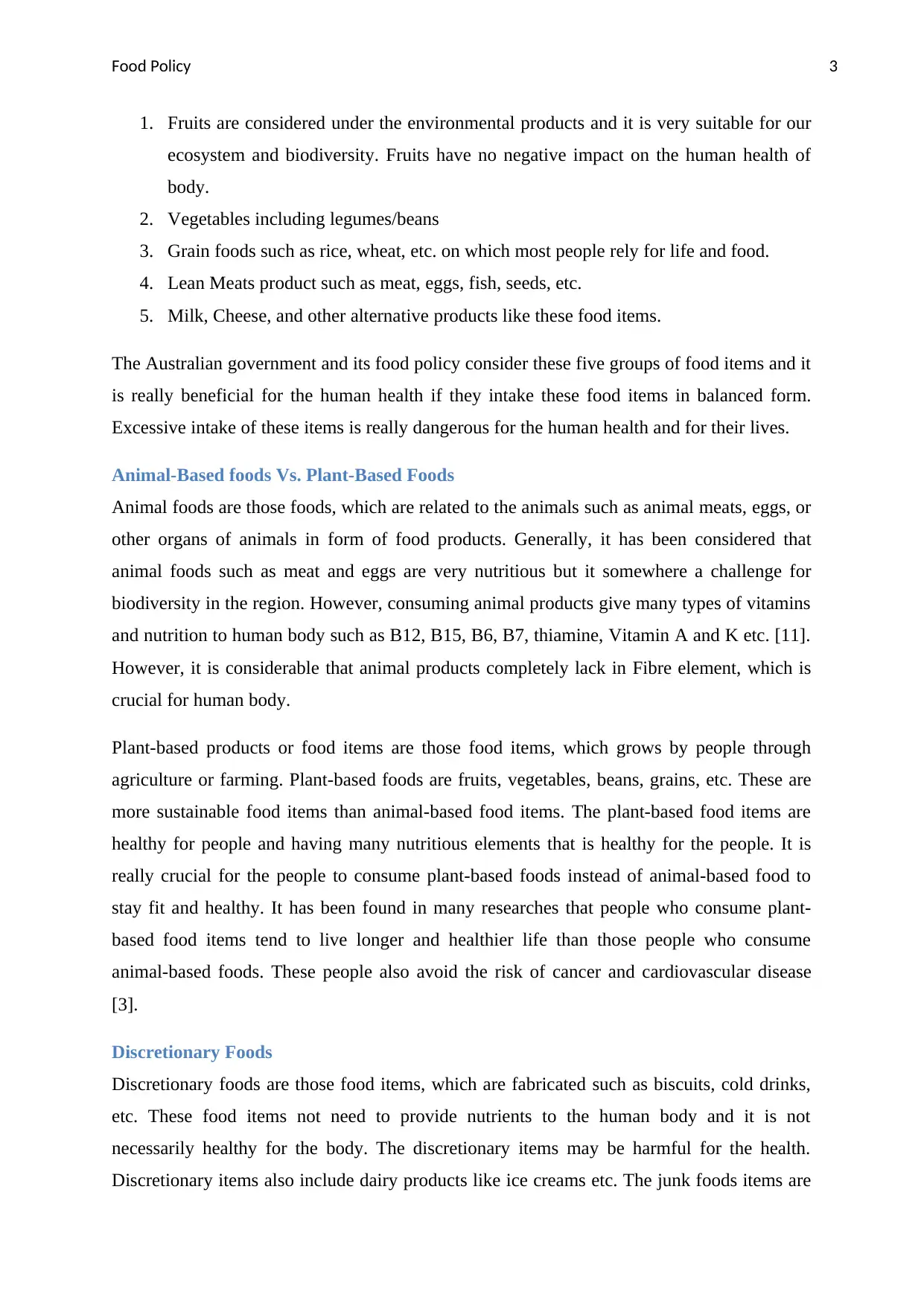
Food Policy 3
1. Fruits are considered under the environmental products and it is very suitable for our
ecosystem and biodiversity. Fruits have no negative impact on the human health of
body.
2. Vegetables including legumes/beans
3. Grain foods such as rice, wheat, etc. on which most people rely for life and food.
4. Lean Meats product such as meat, eggs, fish, seeds, etc.
5. Milk, Cheese, and other alternative products like these food items.
The Australian government and its food policy consider these five groups of food items and it
is really beneficial for the human health if they intake these food items in balanced form.
Excessive intake of these items is really dangerous for the human health and for their lives.
Animal-Based foods Vs. Plant-Based Foods
Animal foods are those foods, which are related to the animals such as animal meats, eggs, or
other organs of animals in form of food products. Generally, it has been considered that
animal foods such as meat and eggs are very nutritious but it somewhere a challenge for
biodiversity in the region. However, consuming animal products give many types of vitamins
and nutrition to human body such as B12, B15, B6, B7, thiamine, Vitamin A and K etc. [11].
However, it is considerable that animal products completely lack in Fibre element, which is
crucial for human body.
Plant-based products or food items are those food items, which grows by people through
agriculture or farming. Plant-based foods are fruits, vegetables, beans, grains, etc. These are
more sustainable food items than animal-based food items. The plant-based food items are
healthy for people and having many nutritious elements that is healthy for the people. It is
really crucial for the people to consume plant-based foods instead of animal-based food to
stay fit and healthy. It has been found in many researches that people who consume plant-
based food items tend to live longer and healthier life than those people who consume
animal-based foods. These people also avoid the risk of cancer and cardiovascular disease
[3].
Discretionary Foods
Discretionary foods are those food items, which are fabricated such as biscuits, cold drinks,
etc. These food items not need to provide nutrients to the human body and it is not
necessarily healthy for the body. The discretionary items may be harmful for the health.
Discretionary items also include dairy products like ice creams etc. The junk foods items are
1. Fruits are considered under the environmental products and it is very suitable for our
ecosystem and biodiversity. Fruits have no negative impact on the human health of
body.
2. Vegetables including legumes/beans
3. Grain foods such as rice, wheat, etc. on which most people rely for life and food.
4. Lean Meats product such as meat, eggs, fish, seeds, etc.
5. Milk, Cheese, and other alternative products like these food items.
The Australian government and its food policy consider these five groups of food items and it
is really beneficial for the human health if they intake these food items in balanced form.
Excessive intake of these items is really dangerous for the human health and for their lives.
Animal-Based foods Vs. Plant-Based Foods
Animal foods are those foods, which are related to the animals such as animal meats, eggs, or
other organs of animals in form of food products. Generally, it has been considered that
animal foods such as meat and eggs are very nutritious but it somewhere a challenge for
biodiversity in the region. However, consuming animal products give many types of vitamins
and nutrition to human body such as B12, B15, B6, B7, thiamine, Vitamin A and K etc. [11].
However, it is considerable that animal products completely lack in Fibre element, which is
crucial for human body.
Plant-based products or food items are those food items, which grows by people through
agriculture or farming. Plant-based foods are fruits, vegetables, beans, grains, etc. These are
more sustainable food items than animal-based food items. The plant-based food items are
healthy for people and having many nutritious elements that is healthy for the people. It is
really crucial for the people to consume plant-based foods instead of animal-based food to
stay fit and healthy. It has been found in many researches that people who consume plant-
based food items tend to live longer and healthier life than those people who consume
animal-based foods. These people also avoid the risk of cancer and cardiovascular disease
[3].
Discretionary Foods
Discretionary foods are those food items, which are fabricated such as biscuits, cold drinks,
etc. These food items not need to provide nutrients to the human body and it is not
necessarily healthy for the body. The discretionary items may be harmful for the health.
Discretionary items also include dairy products like ice creams etc. The junk foods items are
Paraphrase This Document
Need a fresh take? Get an instant paraphrase of this document with our AI Paraphraser
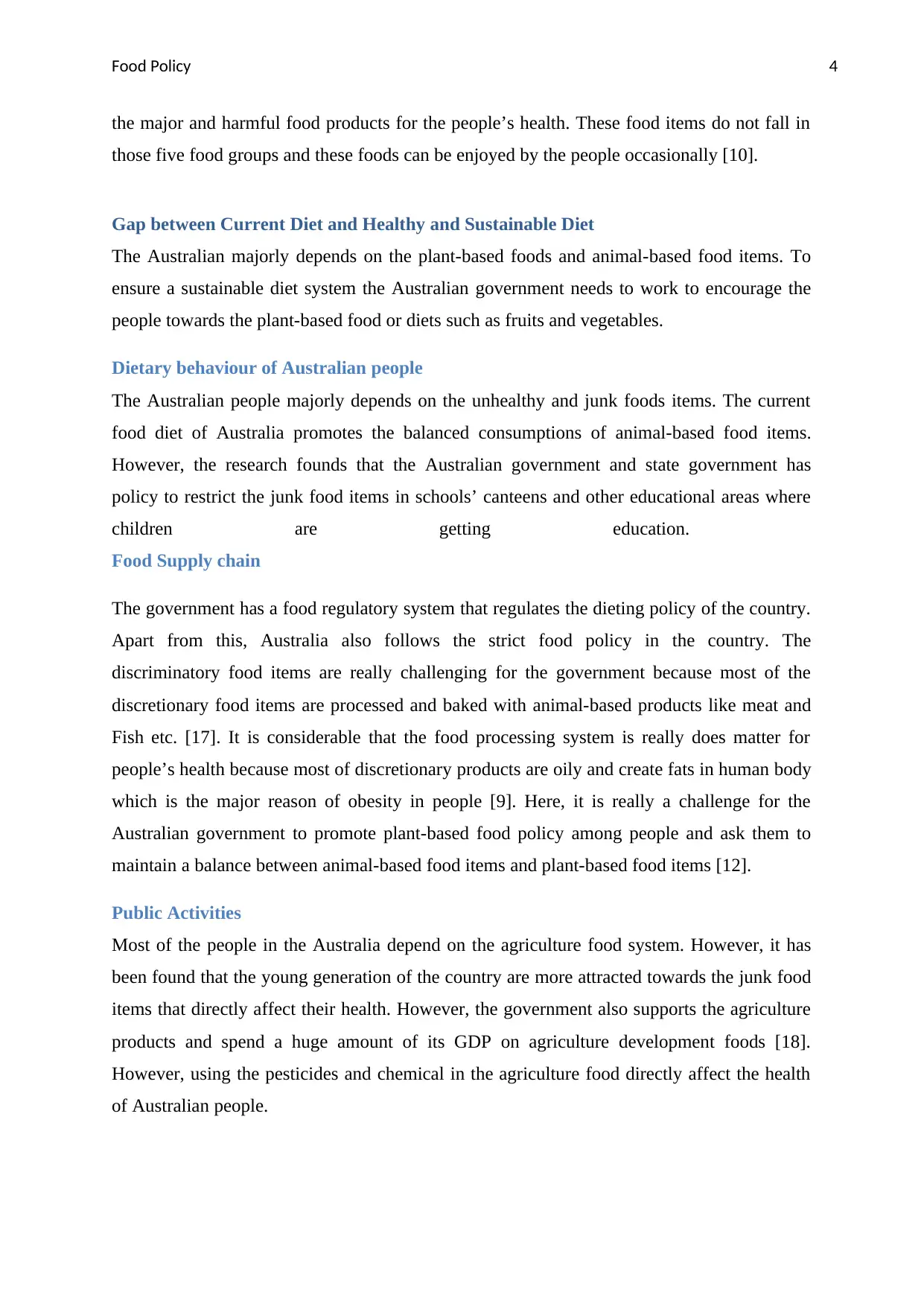
Food Policy 4
the major and harmful food products for the people’s health. These food items do not fall in
those five food groups and these foods can be enjoyed by the people occasionally [10].
Gap between Current Diet and Healthy and Sustainable Diet
The Australian majorly depends on the plant-based foods and animal-based food items. To
ensure a sustainable diet system the Australian government needs to work to encourage the
people towards the plant-based food or diets such as fruits and vegetables.
Dietary behaviour of Australian people
The Australian people majorly depends on the unhealthy and junk foods items. The current
food diet of Australia promotes the balanced consumptions of animal-based food items.
However, the research founds that the Australian government and state government has
policy to restrict the junk food items in schools’ canteens and other educational areas where
children are getting education.
Food Supply chain
The government has a food regulatory system that regulates the dieting policy of the country.
Apart from this, Australia also follows the strict food policy in the country. The
discriminatory food items are really challenging for the government because most of the
discretionary food items are processed and baked with animal-based products like meat and
Fish etc. [17]. It is considerable that the food processing system is really does matter for
people’s health because most of discretionary products are oily and create fats in human body
which is the major reason of obesity in people [9]. Here, it is really a challenge for the
Australian government to promote plant-based food policy among people and ask them to
maintain a balance between animal-based food items and plant-based food items [12].
Public Activities
Most of the people in the Australia depend on the agriculture food system. However, it has
been found that the young generation of the country are more attracted towards the junk food
items that directly affect their health. However, the government also supports the agriculture
products and spend a huge amount of its GDP on agriculture development foods [18].
However, using the pesticides and chemical in the agriculture food directly affect the health
of Australian people.
the major and harmful food products for the people’s health. These food items do not fall in
those five food groups and these foods can be enjoyed by the people occasionally [10].
Gap between Current Diet and Healthy and Sustainable Diet
The Australian majorly depends on the plant-based foods and animal-based food items. To
ensure a sustainable diet system the Australian government needs to work to encourage the
people towards the plant-based food or diets such as fruits and vegetables.
Dietary behaviour of Australian people
The Australian people majorly depends on the unhealthy and junk foods items. The current
food diet of Australia promotes the balanced consumptions of animal-based food items.
However, the research founds that the Australian government and state government has
policy to restrict the junk food items in schools’ canteens and other educational areas where
children are getting education.
Food Supply chain
The government has a food regulatory system that regulates the dieting policy of the country.
Apart from this, Australia also follows the strict food policy in the country. The
discriminatory food items are really challenging for the government because most of the
discretionary food items are processed and baked with animal-based products like meat and
Fish etc. [17]. It is considerable that the food processing system is really does matter for
people’s health because most of discretionary products are oily and create fats in human body
which is the major reason of obesity in people [9]. Here, it is really a challenge for the
Australian government to promote plant-based food policy among people and ask them to
maintain a balance between animal-based food items and plant-based food items [12].
Public Activities
Most of the people in the Australia depend on the agriculture food system. However, it has
been found that the young generation of the country are more attracted towards the junk food
items that directly affect their health. However, the government also supports the agriculture
products and spend a huge amount of its GDP on agriculture development foods [18].
However, using the pesticides and chemical in the agriculture food directly affect the health
of Australian people.
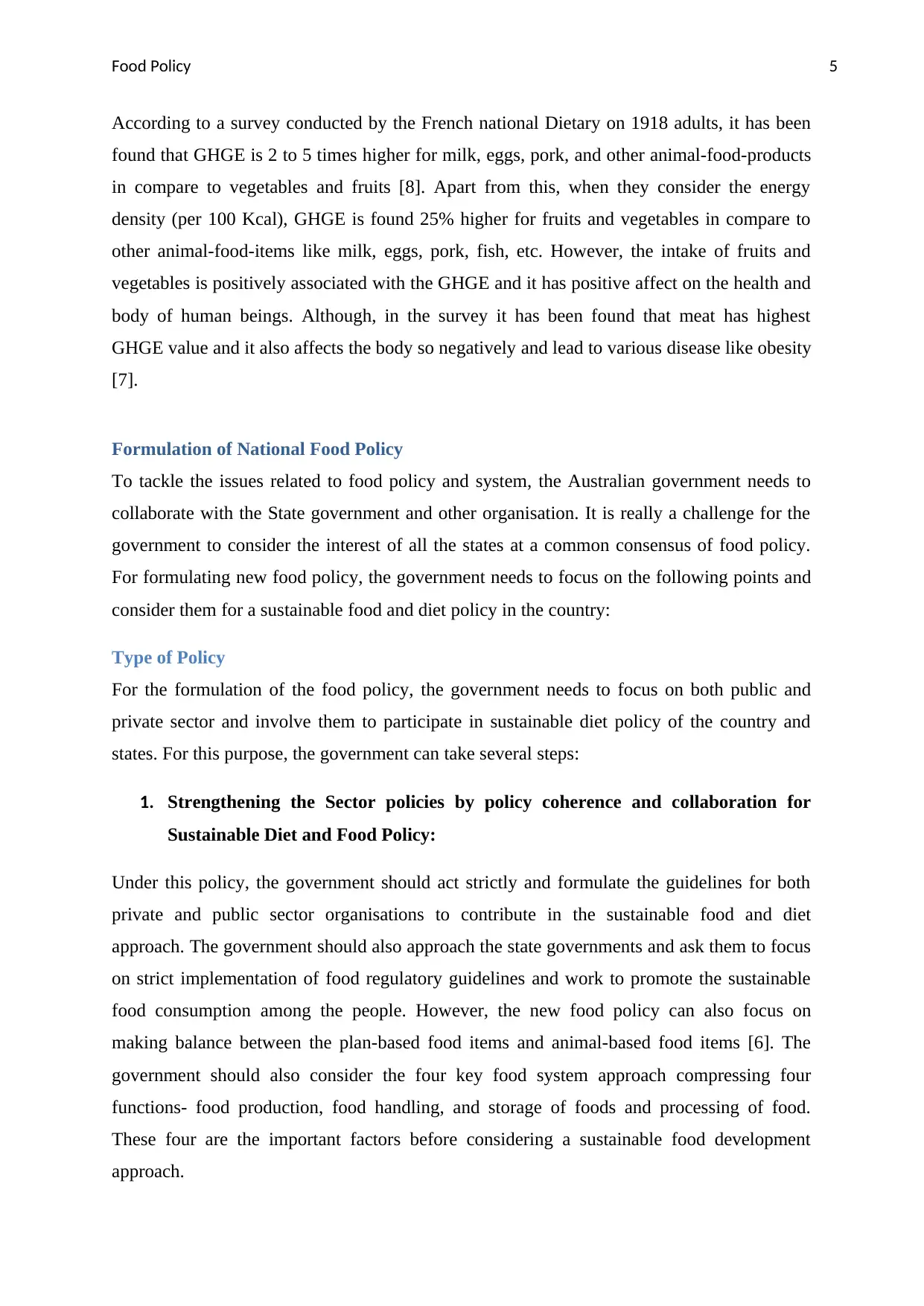
Food Policy 5
According to a survey conducted by the French national Dietary on 1918 adults, it has been
found that GHGE is 2 to 5 times higher for milk, eggs, pork, and other animal-food-products
in compare to vegetables and fruits [8]. Apart from this, when they consider the energy
density (per 100 Kcal), GHGE is found 25% higher for fruits and vegetables in compare to
other animal-food-items like milk, eggs, pork, fish, etc. However, the intake of fruits and
vegetables is positively associated with the GHGE and it has positive affect on the health and
body of human beings. Although, in the survey it has been found that meat has highest
GHGE value and it also affects the body so negatively and lead to various disease like obesity
[7].
Formulation of National Food Policy
To tackle the issues related to food policy and system, the Australian government needs to
collaborate with the State government and other organisation. It is really a challenge for the
government to consider the interest of all the states at a common consensus of food policy.
For formulating new food policy, the government needs to focus on the following points and
consider them for a sustainable food and diet policy in the country:
Type of Policy
For the formulation of the food policy, the government needs to focus on both public and
private sector and involve them to participate in sustainable diet policy of the country and
states. For this purpose, the government can take several steps:
1. Strengthening the Sector policies by policy coherence and collaboration for
Sustainable Diet and Food Policy:
Under this policy, the government should act strictly and formulate the guidelines for both
private and public sector organisations to contribute in the sustainable food and diet
approach. The government should also approach the state governments and ask them to focus
on strict implementation of food regulatory guidelines and work to promote the sustainable
food consumption among the people. However, the new food policy can also focus on
making balance between the plan-based food items and animal-based food items [6]. The
government should also consider the four key food system approach compressing four
functions- food production, food handling, and storage of foods and processing of food.
These four are the important factors before considering a sustainable food development
approach.
According to a survey conducted by the French national Dietary on 1918 adults, it has been
found that GHGE is 2 to 5 times higher for milk, eggs, pork, and other animal-food-products
in compare to vegetables and fruits [8]. Apart from this, when they consider the energy
density (per 100 Kcal), GHGE is found 25% higher for fruits and vegetables in compare to
other animal-food-items like milk, eggs, pork, fish, etc. However, the intake of fruits and
vegetables is positively associated with the GHGE and it has positive affect on the health and
body of human beings. Although, in the survey it has been found that meat has highest
GHGE value and it also affects the body so negatively and lead to various disease like obesity
[7].
Formulation of National Food Policy
To tackle the issues related to food policy and system, the Australian government needs to
collaborate with the State government and other organisation. It is really a challenge for the
government to consider the interest of all the states at a common consensus of food policy.
For formulating new food policy, the government needs to focus on the following points and
consider them for a sustainable food and diet policy in the country:
Type of Policy
For the formulation of the food policy, the government needs to focus on both public and
private sector and involve them to participate in sustainable diet policy of the country and
states. For this purpose, the government can take several steps:
1. Strengthening the Sector policies by policy coherence and collaboration for
Sustainable Diet and Food Policy:
Under this policy, the government should act strictly and formulate the guidelines for both
private and public sector organisations to contribute in the sustainable food and diet
approach. The government should also approach the state governments and ask them to focus
on strict implementation of food regulatory guidelines and work to promote the sustainable
food consumption among the people. However, the new food policy can also focus on
making balance between the plan-based food items and animal-based food items [6]. The
government should also consider the four key food system approach compressing four
functions- food production, food handling, and storage of foods and processing of food.
These four are the important factors before considering a sustainable food development
approach.
⊘ This is a preview!⊘
Do you want full access?
Subscribe today to unlock all pages.

Trusted by 1+ million students worldwide
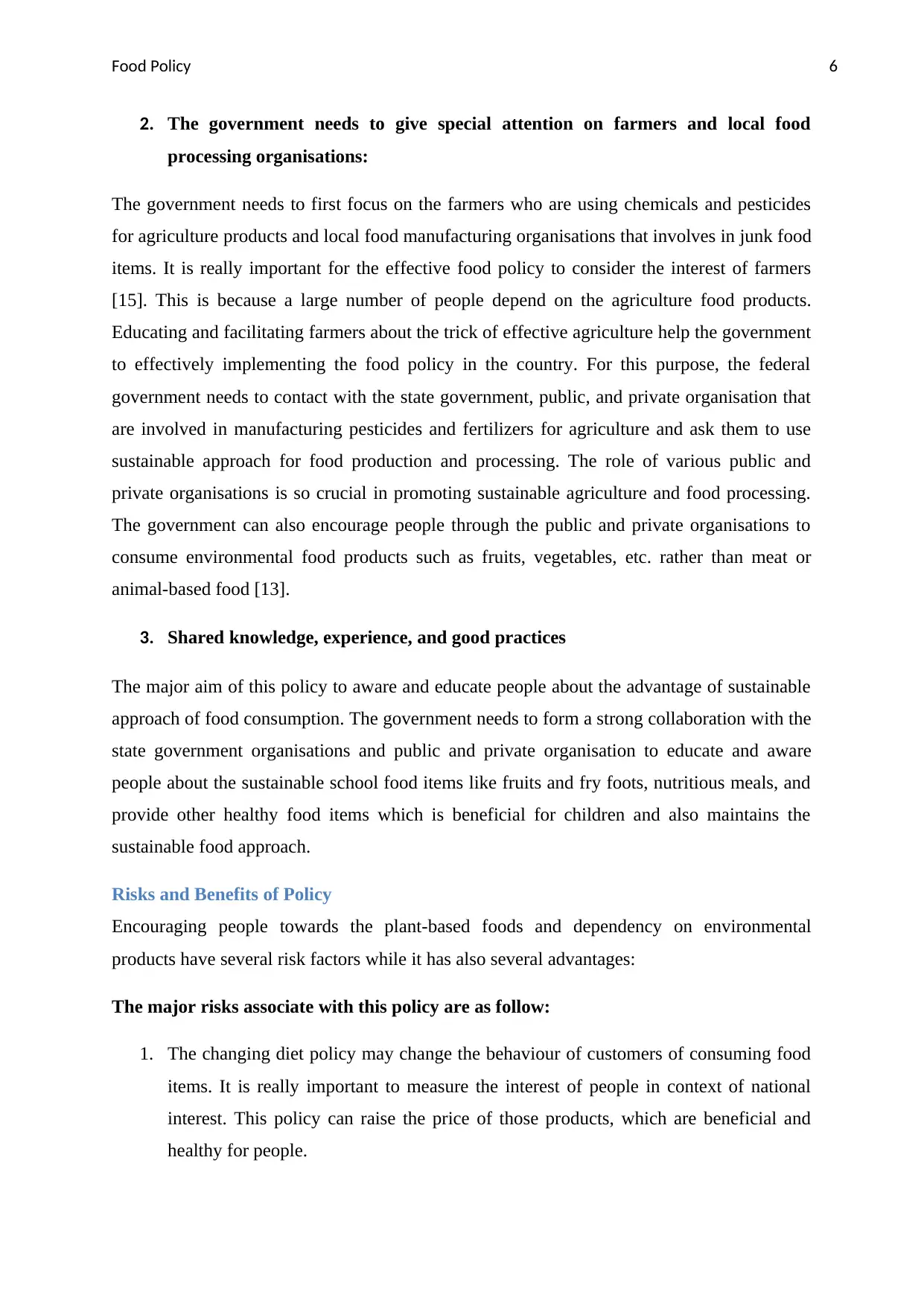
Food Policy 6
2. The government needs to give special attention on farmers and local food
processing organisations:
The government needs to first focus on the farmers who are using chemicals and pesticides
for agriculture products and local food manufacturing organisations that involves in junk food
items. It is really important for the effective food policy to consider the interest of farmers
[15]. This is because a large number of people depend on the agriculture food products.
Educating and facilitating farmers about the trick of effective agriculture help the government
to effectively implementing the food policy in the country. For this purpose, the federal
government needs to contact with the state government, public, and private organisation that
are involved in manufacturing pesticides and fertilizers for agriculture and ask them to use
sustainable approach for food production and processing. The role of various public and
private organisations is so crucial in promoting sustainable agriculture and food processing.
The government can also encourage people through the public and private organisations to
consume environmental food products such as fruits, vegetables, etc. rather than meat or
animal-based food [13].
3. Shared knowledge, experience, and good practices
The major aim of this policy to aware and educate people about the advantage of sustainable
approach of food consumption. The government needs to form a strong collaboration with the
state government organisations and public and private organisation to educate and aware
people about the sustainable school food items like fruits and fry foots, nutritious meals, and
provide other healthy food items which is beneficial for children and also maintains the
sustainable food approach.
Risks and Benefits of Policy
Encouraging people towards the plant-based foods and dependency on environmental
products have several risk factors while it has also several advantages:
The major risks associate with this policy are as follow:
1. The changing diet policy may change the behaviour of customers of consuming food
items. It is really important to measure the interest of people in context of national
interest. This policy can raise the price of those products, which are beneficial and
healthy for people.
2. The government needs to give special attention on farmers and local food
processing organisations:
The government needs to first focus on the farmers who are using chemicals and pesticides
for agriculture products and local food manufacturing organisations that involves in junk food
items. It is really important for the effective food policy to consider the interest of farmers
[15]. This is because a large number of people depend on the agriculture food products.
Educating and facilitating farmers about the trick of effective agriculture help the government
to effectively implementing the food policy in the country. For this purpose, the federal
government needs to contact with the state government, public, and private organisation that
are involved in manufacturing pesticides and fertilizers for agriculture and ask them to use
sustainable approach for food production and processing. The role of various public and
private organisations is so crucial in promoting sustainable agriculture and food processing.
The government can also encourage people through the public and private organisations to
consume environmental food products such as fruits, vegetables, etc. rather than meat or
animal-based food [13].
3. Shared knowledge, experience, and good practices
The major aim of this policy to aware and educate people about the advantage of sustainable
approach of food consumption. The government needs to form a strong collaboration with the
state government organisations and public and private organisation to educate and aware
people about the sustainable school food items like fruits and fry foots, nutritious meals, and
provide other healthy food items which is beneficial for children and also maintains the
sustainable food approach.
Risks and Benefits of Policy
Encouraging people towards the plant-based foods and dependency on environmental
products have several risk factors while it has also several advantages:
The major risks associate with this policy are as follow:
1. The changing diet policy may change the behaviour of customers of consuming food
items. It is really important to measure the interest of people in context of national
interest. This policy can raise the price of those products, which are beneficial and
healthy for people.
Paraphrase This Document
Need a fresh take? Get an instant paraphrase of this document with our AI Paraphraser
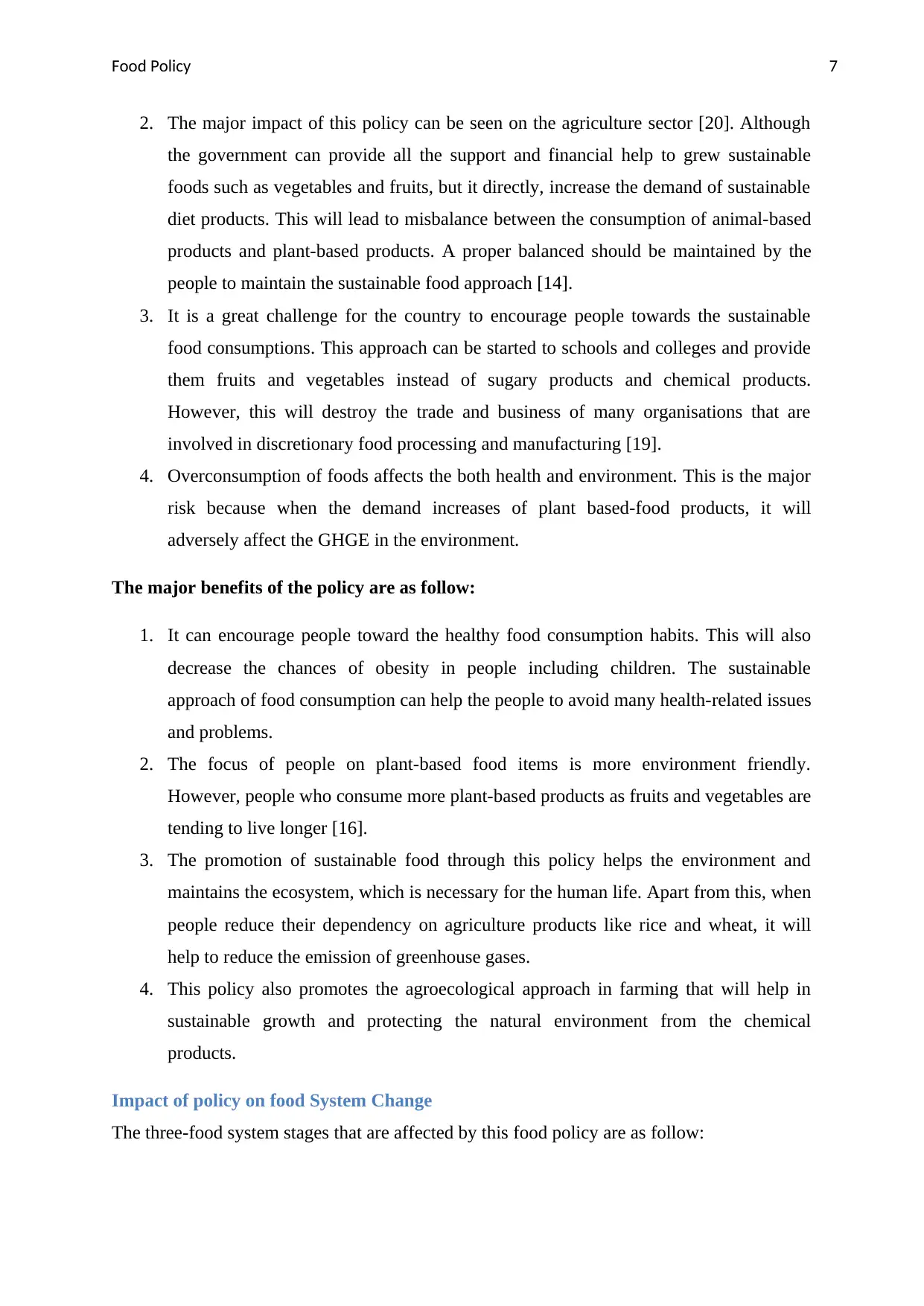
Food Policy 7
2. The major impact of this policy can be seen on the agriculture sector [20]. Although
the government can provide all the support and financial help to grew sustainable
foods such as vegetables and fruits, but it directly, increase the demand of sustainable
diet products. This will lead to misbalance between the consumption of animal-based
products and plant-based products. A proper balanced should be maintained by the
people to maintain the sustainable food approach [14].
3. It is a great challenge for the country to encourage people towards the sustainable
food consumptions. This approach can be started to schools and colleges and provide
them fruits and vegetables instead of sugary products and chemical products.
However, this will destroy the trade and business of many organisations that are
involved in discretionary food processing and manufacturing [19].
4. Overconsumption of foods affects the both health and environment. This is the major
risk because when the demand increases of plant based-food products, it will
adversely affect the GHGE in the environment.
The major benefits of the policy are as follow:
1. It can encourage people toward the healthy food consumption habits. This will also
decrease the chances of obesity in people including children. The sustainable
approach of food consumption can help the people to avoid many health-related issues
and problems.
2. The focus of people on plant-based food items is more environment friendly.
However, people who consume more plant-based products as fruits and vegetables are
tending to live longer [16].
3. The promotion of sustainable food through this policy helps the environment and
maintains the ecosystem, which is necessary for the human life. Apart from this, when
people reduce their dependency on agriculture products like rice and wheat, it will
help to reduce the emission of greenhouse gases.
4. This policy also promotes the agroecological approach in farming that will help in
sustainable growth and protecting the natural environment from the chemical
products.
Impact of policy on food System Change
The three-food system stages that are affected by this food policy are as follow:
2. The major impact of this policy can be seen on the agriculture sector [20]. Although
the government can provide all the support and financial help to grew sustainable
foods such as vegetables and fruits, but it directly, increase the demand of sustainable
diet products. This will lead to misbalance between the consumption of animal-based
products and plant-based products. A proper balanced should be maintained by the
people to maintain the sustainable food approach [14].
3. It is a great challenge for the country to encourage people towards the sustainable
food consumptions. This approach can be started to schools and colleges and provide
them fruits and vegetables instead of sugary products and chemical products.
However, this will destroy the trade and business of many organisations that are
involved in discretionary food processing and manufacturing [19].
4. Overconsumption of foods affects the both health and environment. This is the major
risk because when the demand increases of plant based-food products, it will
adversely affect the GHGE in the environment.
The major benefits of the policy are as follow:
1. It can encourage people toward the healthy food consumption habits. This will also
decrease the chances of obesity in people including children. The sustainable
approach of food consumption can help the people to avoid many health-related issues
and problems.
2. The focus of people on plant-based food items is more environment friendly.
However, people who consume more plant-based products as fruits and vegetables are
tending to live longer [16].
3. The promotion of sustainable food through this policy helps the environment and
maintains the ecosystem, which is necessary for the human life. Apart from this, when
people reduce their dependency on agriculture products like rice and wheat, it will
help to reduce the emission of greenhouse gases.
4. This policy also promotes the agroecological approach in farming that will help in
sustainable growth and protecting the natural environment from the chemical
products.
Impact of policy on food System Change
The three-food system stages that are affected by this food policy are as follow:
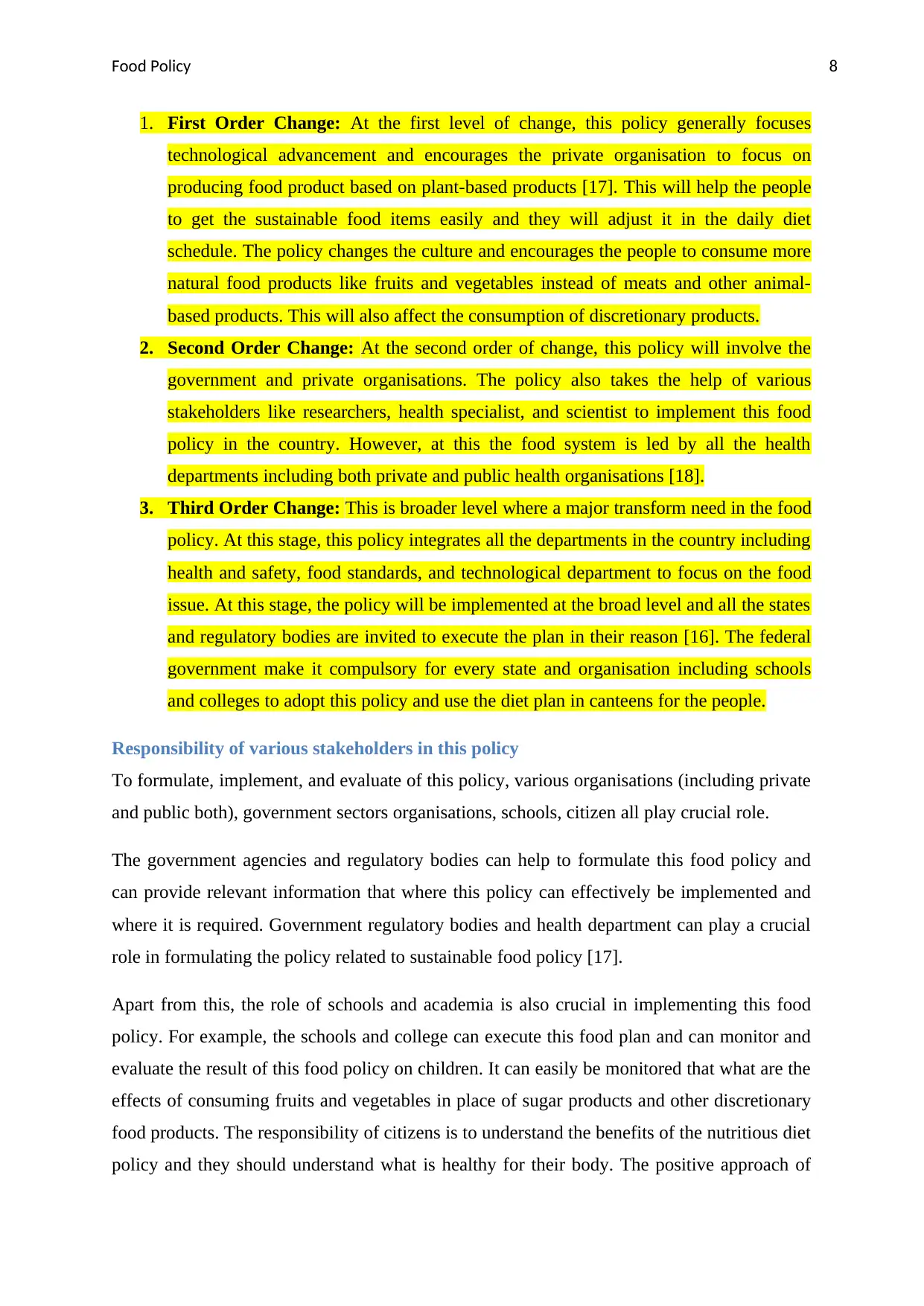
Food Policy 8
1. First Order Change: At the first level of change, this policy generally focuses
technological advancement and encourages the private organisation to focus on
producing food product based on plant-based products [17]. This will help the people
to get the sustainable food items easily and they will adjust it in the daily diet
schedule. The policy changes the culture and encourages the people to consume more
natural food products like fruits and vegetables instead of meats and other animal-
based products. This will also affect the consumption of discretionary products.
2. Second Order Change: At the second order of change, this policy will involve the
government and private organisations. The policy also takes the help of various
stakeholders like researchers, health specialist, and scientist to implement this food
policy in the country. However, at this the food system is led by all the health
departments including both private and public health organisations [18].
3. Third Order Change: This is broader level where a major transform need in the food
policy. At this stage, this policy integrates all the departments in the country including
health and safety, food standards, and technological department to focus on the food
issue. At this stage, the policy will be implemented at the broad level and all the states
and regulatory bodies are invited to execute the plan in their reason [16]. The federal
government make it compulsory for every state and organisation including schools
and colleges to adopt this policy and use the diet plan in canteens for the people.
Responsibility of various stakeholders in this policy
To formulate, implement, and evaluate of this policy, various organisations (including private
and public both), government sectors organisations, schools, citizen all play crucial role.
The government agencies and regulatory bodies can help to formulate this food policy and
can provide relevant information that where this policy can effectively be implemented and
where it is required. Government regulatory bodies and health department can play a crucial
role in formulating the policy related to sustainable food policy [17].
Apart from this, the role of schools and academia is also crucial in implementing this food
policy. For example, the schools and college can execute this food plan and can monitor and
evaluate the result of this food policy on children. It can easily be monitored that what are the
effects of consuming fruits and vegetables in place of sugar products and other discretionary
food products. The responsibility of citizens is to understand the benefits of the nutritious diet
policy and they should understand what is healthy for their body. The positive approach of
1. First Order Change: At the first level of change, this policy generally focuses
technological advancement and encourages the private organisation to focus on
producing food product based on plant-based products [17]. This will help the people
to get the sustainable food items easily and they will adjust it in the daily diet
schedule. The policy changes the culture and encourages the people to consume more
natural food products like fruits and vegetables instead of meats and other animal-
based products. This will also affect the consumption of discretionary products.
2. Second Order Change: At the second order of change, this policy will involve the
government and private organisations. The policy also takes the help of various
stakeholders like researchers, health specialist, and scientist to implement this food
policy in the country. However, at this the food system is led by all the health
departments including both private and public health organisations [18].
3. Third Order Change: This is broader level where a major transform need in the food
policy. At this stage, this policy integrates all the departments in the country including
health and safety, food standards, and technological department to focus on the food
issue. At this stage, the policy will be implemented at the broad level and all the states
and regulatory bodies are invited to execute the plan in their reason [16]. The federal
government make it compulsory for every state and organisation including schools
and colleges to adopt this policy and use the diet plan in canteens for the people.
Responsibility of various stakeholders in this policy
To formulate, implement, and evaluate of this policy, various organisations (including private
and public both), government sectors organisations, schools, citizen all play crucial role.
The government agencies and regulatory bodies can help to formulate this food policy and
can provide relevant information that where this policy can effectively be implemented and
where it is required. Government regulatory bodies and health department can play a crucial
role in formulating the policy related to sustainable food policy [17].
Apart from this, the role of schools and academia is also crucial in implementing this food
policy. For example, the schools and college can execute this food plan and can monitor and
evaluate the result of this food policy on children. It can easily be monitored that what are the
effects of consuming fruits and vegetables in place of sugar products and other discretionary
food products. The responsibility of citizens is to understand the benefits of the nutritious diet
policy and they should understand what is healthy for their body. The positive approach of
⊘ This is a preview!⊘
Do you want full access?
Subscribe today to unlock all pages.

Trusted by 1+ million students worldwide
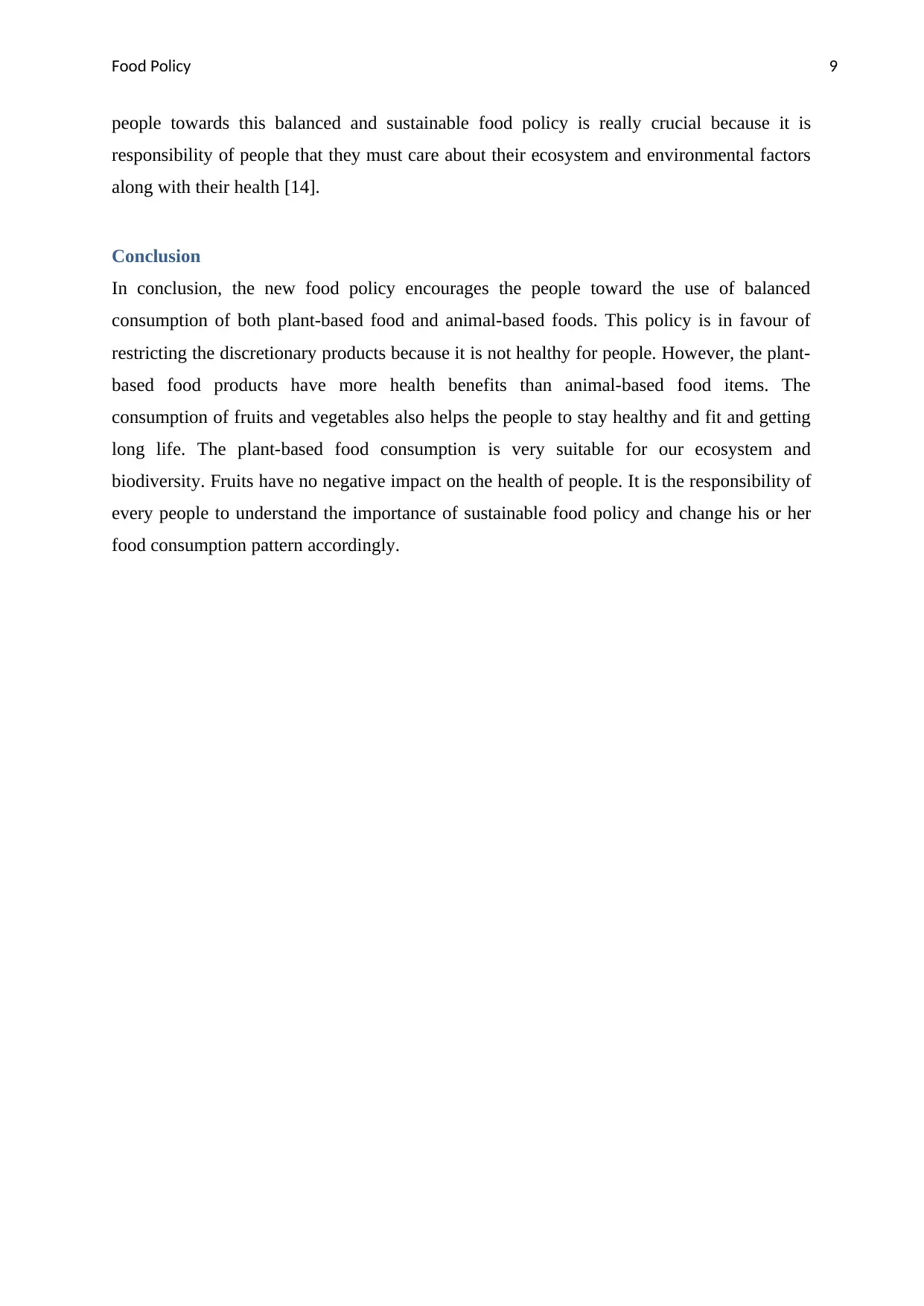
Food Policy 9
people towards this balanced and sustainable food policy is really crucial because it is
responsibility of people that they must care about their ecosystem and environmental factors
along with their health [14].
Conclusion
In conclusion, the new food policy encourages the people toward the use of balanced
consumption of both plant-based food and animal-based foods. This policy is in favour of
restricting the discretionary products because it is not healthy for people. However, the plant-
based food products have more health benefits than animal-based food items. The
consumption of fruits and vegetables also helps the people to stay healthy and fit and getting
long life. The plant-based food consumption is very suitable for our ecosystem and
biodiversity. Fruits have no negative impact on the health of people. It is the responsibility of
every people to understand the importance of sustainable food policy and change his or her
food consumption pattern accordingly.
people towards this balanced and sustainable food policy is really crucial because it is
responsibility of people that they must care about their ecosystem and environmental factors
along with their health [14].
Conclusion
In conclusion, the new food policy encourages the people toward the use of balanced
consumption of both plant-based food and animal-based foods. This policy is in favour of
restricting the discretionary products because it is not healthy for people. However, the plant-
based food products have more health benefits than animal-based food items. The
consumption of fruits and vegetables also helps the people to stay healthy and fit and getting
long life. The plant-based food consumption is very suitable for our ecosystem and
biodiversity. Fruits have no negative impact on the health of people. It is the responsibility of
every people to understand the importance of sustainable food policy and change his or her
food consumption pattern accordingly.
Paraphrase This Document
Need a fresh take? Get an instant paraphrase of this document with our AI Paraphraser
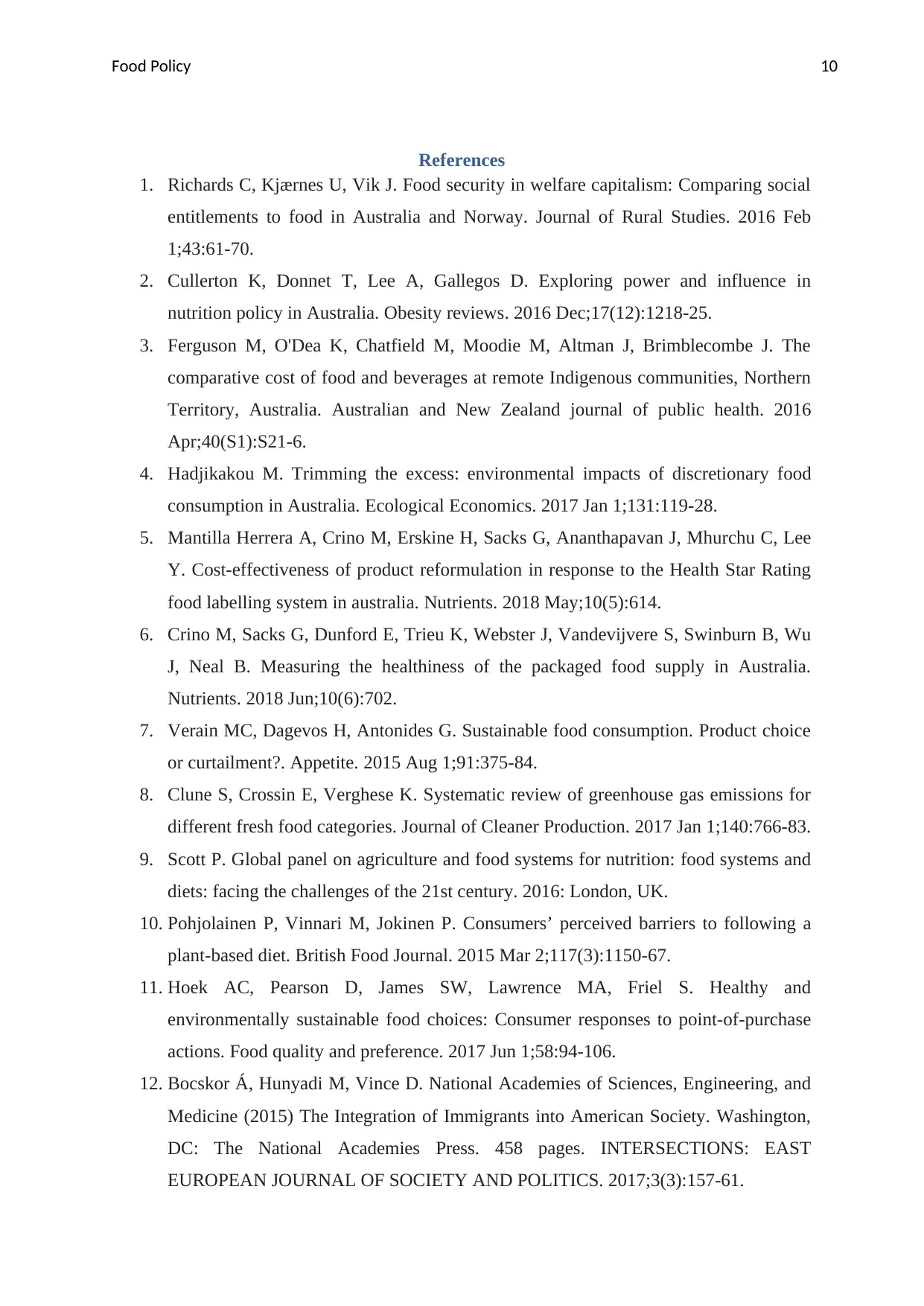
Food Policy 10
References
1. Richards C, Kjærnes U, Vik J. Food security in welfare capitalism: Comparing social
entitlements to food in Australia and Norway. Journal of Rural Studies. 2016 Feb
1;43:61-70.
2. Cullerton K, Donnet T, Lee A, Gallegos D. Exploring power and influence in
nutrition policy in Australia. Obesity reviews. 2016 Dec;17(12):1218-25.
3. Ferguson M, O'Dea K, Chatfield M, Moodie M, Altman J, Brimblecombe J. The
comparative cost of food and beverages at remote Indigenous communities, Northern
Territory, Australia. Australian and New Zealand journal of public health. 2016
Apr;40(S1):S21-6.
4. Hadjikakou M. Trimming the excess: environmental impacts of discretionary food
consumption in Australia. Ecological Economics. 2017 Jan 1;131:119-28.
5. Mantilla Herrera A, Crino M, Erskine H, Sacks G, Ananthapavan J, Mhurchu C, Lee
Y. Cost-effectiveness of product reformulation in response to the Health Star Rating
food labelling system in australia. Nutrients. 2018 May;10(5):614.
6. Crino M, Sacks G, Dunford E, Trieu K, Webster J, Vandevijvere S, Swinburn B, Wu
J, Neal B. Measuring the healthiness of the packaged food supply in Australia.
Nutrients. 2018 Jun;10(6):702.
7. Verain MC, Dagevos H, Antonides G. Sustainable food consumption. Product choice
or curtailment?. Appetite. 2015 Aug 1;91:375-84.
8. Clune S, Crossin E, Verghese K. Systematic review of greenhouse gas emissions for
different fresh food categories. Journal of Cleaner Production. 2017 Jan 1;140:766-83.
9. Scott P. Global panel on agriculture and food systems for nutrition: food systems and
diets: facing the challenges of the 21st century. 2016: London, UK.
10. Pohjolainen P, Vinnari M, Jokinen P. Consumers’ perceived barriers to following a
plant-based diet. British Food Journal. 2015 Mar 2;117(3):1150-67.
11. Hoek AC, Pearson D, James SW, Lawrence MA, Friel S. Healthy and
environmentally sustainable food choices: Consumer responses to point-of-purchase
actions. Food quality and preference. 2017 Jun 1;58:94-106.
12. Bocskor Á, Hunyadi M, Vince D. National Academies of Sciences, Engineering, and
Medicine (2015) The Integration of Immigrants into American Society. Washington,
DC: The National Academies Press. 458 pages. INTERSECTIONS: EAST
EUROPEAN JOURNAL OF SOCIETY AND POLITICS. 2017;3(3):157-61.
References
1. Richards C, Kjærnes U, Vik J. Food security in welfare capitalism: Comparing social
entitlements to food in Australia and Norway. Journal of Rural Studies. 2016 Feb
1;43:61-70.
2. Cullerton K, Donnet T, Lee A, Gallegos D. Exploring power and influence in
nutrition policy in Australia. Obesity reviews. 2016 Dec;17(12):1218-25.
3. Ferguson M, O'Dea K, Chatfield M, Moodie M, Altman J, Brimblecombe J. The
comparative cost of food and beverages at remote Indigenous communities, Northern
Territory, Australia. Australian and New Zealand journal of public health. 2016
Apr;40(S1):S21-6.
4. Hadjikakou M. Trimming the excess: environmental impacts of discretionary food
consumption in Australia. Ecological Economics. 2017 Jan 1;131:119-28.
5. Mantilla Herrera A, Crino M, Erskine H, Sacks G, Ananthapavan J, Mhurchu C, Lee
Y. Cost-effectiveness of product reformulation in response to the Health Star Rating
food labelling system in australia. Nutrients. 2018 May;10(5):614.
6. Crino M, Sacks G, Dunford E, Trieu K, Webster J, Vandevijvere S, Swinburn B, Wu
J, Neal B. Measuring the healthiness of the packaged food supply in Australia.
Nutrients. 2018 Jun;10(6):702.
7. Verain MC, Dagevos H, Antonides G. Sustainable food consumption. Product choice
or curtailment?. Appetite. 2015 Aug 1;91:375-84.
8. Clune S, Crossin E, Verghese K. Systematic review of greenhouse gas emissions for
different fresh food categories. Journal of Cleaner Production. 2017 Jan 1;140:766-83.
9. Scott P. Global panel on agriculture and food systems for nutrition: food systems and
diets: facing the challenges of the 21st century. 2016: London, UK.
10. Pohjolainen P, Vinnari M, Jokinen P. Consumers’ perceived barriers to following a
plant-based diet. British Food Journal. 2015 Mar 2;117(3):1150-67.
11. Hoek AC, Pearson D, James SW, Lawrence MA, Friel S. Healthy and
environmentally sustainable food choices: Consumer responses to point-of-purchase
actions. Food quality and preference. 2017 Jun 1;58:94-106.
12. Bocskor Á, Hunyadi M, Vince D. National Academies of Sciences, Engineering, and
Medicine (2015) The Integration of Immigrants into American Society. Washington,
DC: The National Academies Press. 458 pages. INTERSECTIONS: EAST
EUROPEAN JOURNAL OF SOCIETY AND POLITICS. 2017;3(3):157-61.
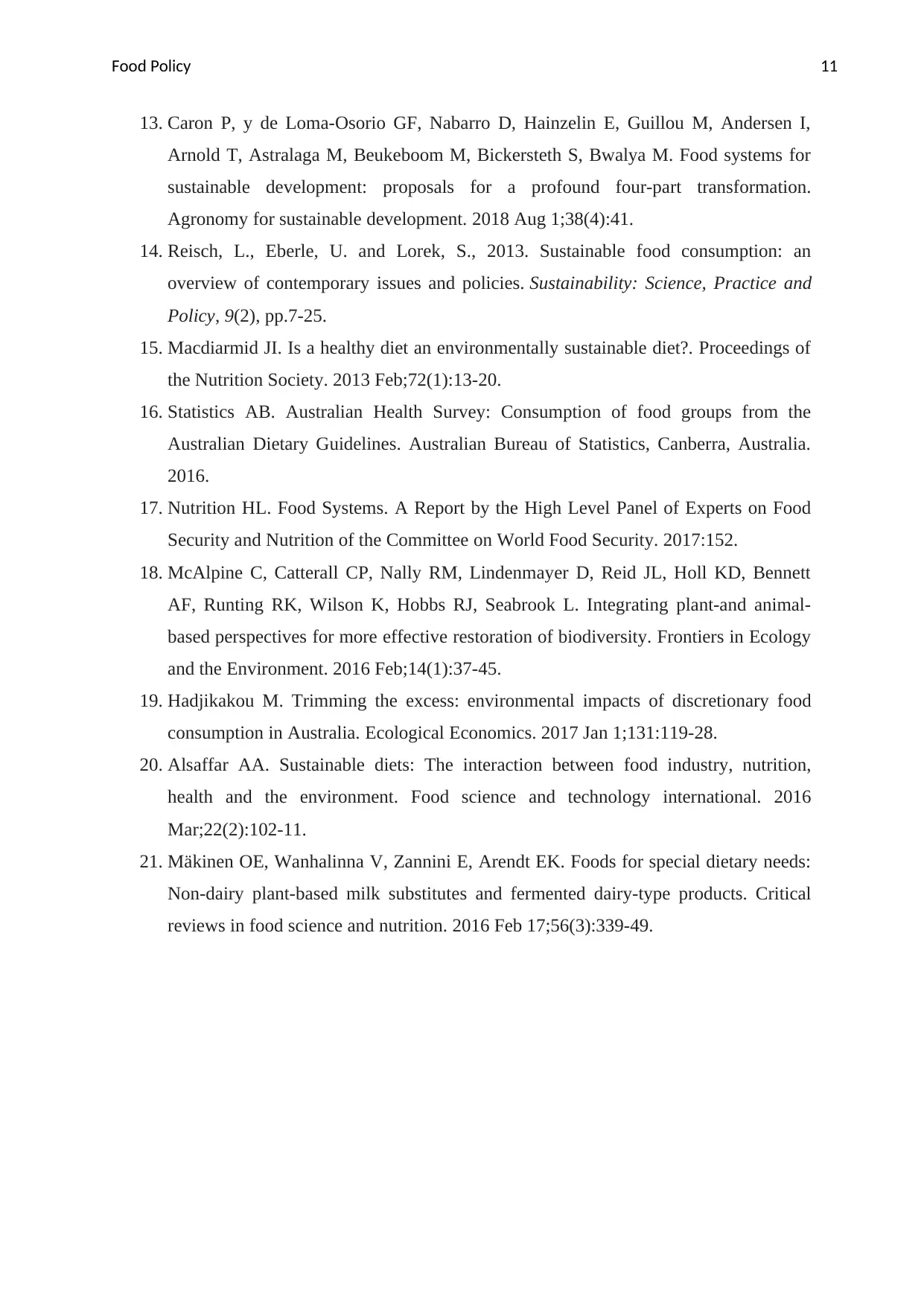
Food Policy 11
13. Caron P, y de Loma-Osorio GF, Nabarro D, Hainzelin E, Guillou M, Andersen I,
Arnold T, Astralaga M, Beukeboom M, Bickersteth S, Bwalya M. Food systems for
sustainable development: proposals for a profound four-part transformation.
Agronomy for sustainable development. 2018 Aug 1;38(4):41.
14. Reisch, L., Eberle, U. and Lorek, S., 2013. Sustainable food consumption: an
overview of contemporary issues and policies. Sustainability: Science, Practice and
Policy, 9(2), pp.7-25.
15. Macdiarmid JI. Is a healthy diet an environmentally sustainable diet?. Proceedings of
the Nutrition Society. 2013 Feb;72(1):13-20.
16. Statistics AB. Australian Health Survey: Consumption of food groups from the
Australian Dietary Guidelines. Australian Bureau of Statistics, Canberra, Australia.
2016.
17. Nutrition HL. Food Systems. A Report by the High Level Panel of Experts on Food
Security and Nutrition of the Committee on World Food Security. 2017:152.
18. McAlpine C, Catterall CP, Nally RM, Lindenmayer D, Reid JL, Holl KD, Bennett
AF, Runting RK, Wilson K, Hobbs RJ, Seabrook L. Integrating plant‐and animal‐
based perspectives for more effective restoration of biodiversity. Frontiers in Ecology
and the Environment. 2016 Feb;14(1):37-45.
19. Hadjikakou M. Trimming the excess: environmental impacts of discretionary food
consumption in Australia. Ecological Economics. 2017 Jan 1;131:119-28.
20. Alsaffar AA. Sustainable diets: The interaction between food industry, nutrition,
health and the environment. Food science and technology international. 2016
Mar;22(2):102-11.
21. Mäkinen OE, Wanhalinna V, Zannini E, Arendt EK. Foods for special dietary needs:
Non-dairy plant-based milk substitutes and fermented dairy-type products. Critical
reviews in food science and nutrition. 2016 Feb 17;56(3):339-49.
13. Caron P, y de Loma-Osorio GF, Nabarro D, Hainzelin E, Guillou M, Andersen I,
Arnold T, Astralaga M, Beukeboom M, Bickersteth S, Bwalya M. Food systems for
sustainable development: proposals for a profound four-part transformation.
Agronomy for sustainable development. 2018 Aug 1;38(4):41.
14. Reisch, L., Eberle, U. and Lorek, S., 2013. Sustainable food consumption: an
overview of contemporary issues and policies. Sustainability: Science, Practice and
Policy, 9(2), pp.7-25.
15. Macdiarmid JI. Is a healthy diet an environmentally sustainable diet?. Proceedings of
the Nutrition Society. 2013 Feb;72(1):13-20.
16. Statistics AB. Australian Health Survey: Consumption of food groups from the
Australian Dietary Guidelines. Australian Bureau of Statistics, Canberra, Australia.
2016.
17. Nutrition HL. Food Systems. A Report by the High Level Panel of Experts on Food
Security and Nutrition of the Committee on World Food Security. 2017:152.
18. McAlpine C, Catterall CP, Nally RM, Lindenmayer D, Reid JL, Holl KD, Bennett
AF, Runting RK, Wilson K, Hobbs RJ, Seabrook L. Integrating plant‐and animal‐
based perspectives for more effective restoration of biodiversity. Frontiers in Ecology
and the Environment. 2016 Feb;14(1):37-45.
19. Hadjikakou M. Trimming the excess: environmental impacts of discretionary food
consumption in Australia. Ecological Economics. 2017 Jan 1;131:119-28.
20. Alsaffar AA. Sustainable diets: The interaction between food industry, nutrition,
health and the environment. Food science and technology international. 2016
Mar;22(2):102-11.
21. Mäkinen OE, Wanhalinna V, Zannini E, Arendt EK. Foods for special dietary needs:
Non-dairy plant-based milk substitutes and fermented dairy-type products. Critical
reviews in food science and nutrition. 2016 Feb 17;56(3):339-49.
⊘ This is a preview!⊘
Do you want full access?
Subscribe today to unlock all pages.

Trusted by 1+ million students worldwide
1 out of 13
Related Documents
Your All-in-One AI-Powered Toolkit for Academic Success.
+13062052269
info@desklib.com
Available 24*7 on WhatsApp / Email
![[object Object]](/_next/static/media/star-bottom.7253800d.svg)
Unlock your academic potential
Copyright © 2020–2025 A2Z Services. All Rights Reserved. Developed and managed by ZUCOL.





